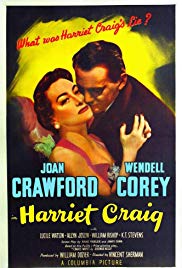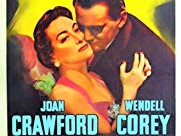Harriet Craig *** (1950, Joan Crawford, Wendell Corey, Lucile Watson) – Classic Movie Review 7,583

Joan Crawford gives quite a tour-de-force performance as the monstrous Mrs Craig in director Vincent Sherman’s 1950 drama film Harriet Craig.
Joan Crawford is the monstrous Mrs Craig in director Vincent Sherman’s 1950 drama film Harriet Craig, a remake of Dorothy Arzner’s 1936 Rosalind Russell vehicle Craig’s Wife, from George Kelly’s Pulitzer prize-winning play of that name. Craig’s Wife was a remake of Craig’s Wife (1928), directed by William C de Mille and starring Irene Rich.
Here Crawford dominates her kind weakling husband Walter (a solid Wendell Corey) and prefers home and possessions to the people around her in a psychology-inclined re-reading of the original play.
Crawford gives quite a tour-de-force performance, as expected of her, but when she is not on screen it all starts to get very dull and Sherman’s direction tends to be stodgy. However, Allyn Joslyn (as Billy Birkmire), William Bishop (as Wes Miller) and Lucile Watson (as Celia Fenwick) make a strong impression in support roles.
Also in the cast are K T Stevens as Clare Raymond, Viola Roache as Mrs Harold, Raymond Greenleaf as Henry Fenwick, Ellen Corby as Lottie, Fiona O’Shiel, Patric Mitchell, Virginia Brissac, Kathryn Card, Mira McKinney, Al Murphy, Susanne Rosser, Charles Evans, Douglas Wood, and Katherine Warren.
Anne Froelich and James Gunn adapt the play Craig’s Wife by the famous playwright George Kelly, the uncle of Grace Kelly.
Harriet Craig is directed by Vincent Sherman, runs 94 minutes, is made and released by Columbia, is written by Anne Froelich and James Gunn, based on George Kelly’s play Craig’s Wife, is shot in black and white by Joseph Walker, is produced by William Dozier, is scored by George Duning and Morris W Stoloff, and is designed by Walter Holscher.
The Broadway play Craig’s Wife opened on 12 October 1925 at the Morosco Theater, and ran for 360 performances before winning the Pulitzer Prize for Drama in 1926.
Harriet’s speech at the climax was written by Crawford, incorporating elements of her own life story.
On Sherman’s advice that she was unsuited for the part, Crawford declined the title role and Margaret Sullavan assigned. But Crawford changed her mind when Sherman was contracted to direct the film, in view of their success with The Damned Don’t Cry (1950). They went on to make a third together, Goodbye, My Fancy (1951).
Crawford’s good friend, former film actor and renowned interior decorator William Haines, designed the sets, uncredited.
In 1933, MGM studio head Louis B Mayer delivered an ultimatum to Haines to choose between a sham lavender marriage or his relationship with Jimmie Shields, whom he met in 1926. Haines chose Shields and Mayer terminated Haines’s contract and he made only a few minor films at Poverty Row studios before retiring from acting.
Haines and Shields remained together for 47 years. They began a successful dual career as interior designers and antique dealers. Haines renovated Crawford’s Brentwood home with an all-white décor for her living room. In 1956, he decorated Crawford’s newly renovated two-floor apartment.
© Derek Winnert 2018 Classic Movie Review 7,583
Check out more reviews on http://derekwinnert.com


